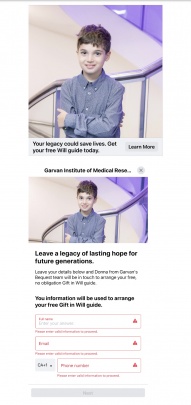Donor stewardship can be a daunting job. Figuring out what resonates with donors, how to inspire them, and how to increase their engagement with our charity requires thought, planning, and creativity. In legacy fundraising, stewarding donors is even more complex. One never entirely knows if the donor will, in fact, leave a gift in their will.
There is great legacy marketing out there – but there’s A LOT of not so good marketing as well!
So the question is: what makes for great marketing?
Many things contribute to great marketing but at the end of the day, it really comes down to one thing: EMOTION.
Copy that compels donors to feel an emotion strongly enough to take action is a successful piece of marketing.
Over the next three posts, we’ll deconstruct and explore good legacy marketing for different stages of a legacy pipeline: enquirers, intenders, and pledgers. As we progress through the posts, you’ll see how legacy marketing should evolve and vary based on the stage.
Enquirers
First things first, who are enquirers? They’re the donors that ask for information on your legacy program or that you have approached through various means (direct mail, surveys, ads, etc.) to begin a legacy conversation.
At this initial stage, the legacy marketing should be inviting, inclusive, exciting, and heartfelt. What you are trying to do is build trust and remind the donor why they love the charity’s mission.
The most amazing marketing helps the donors tap into their autobiographical memory. What is that and why should you care?
The autobiographical memories are the memories of significant personal events and experiences from a person’s life. This is important because it helps the donor connect to the values that have marked their life across significant events. A great example of how the autobiographical memory concept was used for legacy marketing is UNICEF UNICEF UK’s We Are The Generation campaign back in 2016.
In addition, telling impactful stories from both living and passed donors can help your enquirers visualize what inspired other legacy pledgers to include a gift in their will. This uses the concept of social proof which shows the enquirer that someone else like them also made a gift and therefore there’s proof that it’s a normal act.
The following story from a donor at WWF UK tells the story of Kathleen Cuthbert, a longtime donor of the organization.

Lastly, great legacy enquirer marketing is where the donors are. For instance Facebook is a great place to collect leads and the Garvan Institute of Medical Research in Australia created something simple, quick, and easy for prospective legacy donors to receive information. In this case, it offered a free guide.
Is it simple? Yes! Overly creative? No!
But it does the job to pull leads so the legacy officer can then start building the relationship.

These are just three simple examples from countless others. If you apply just one tip from this post, you’re already doing way better than others. Come back for the next post where we’ll explore good legacy marketing for considerers and intenders.


